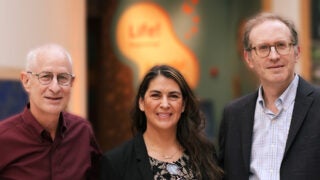
Brett Feldman, center, and Sandra Valencia of USC Street Medicine treat a homeless patient in this file photo. (USC Photo/Gus Ruelas)
Homelessness in L.A. drops for second year in a row: 4 takeaways from the 2025 count
USC researchers involved in the count explain key findings on homelessness in the county.
Homelessness in Los Angeles County declined for the second consecutive year, according to results from the 2025 Greater Los Angeles Homeless Count.
The Los Angeles Homeless Services Authority announced that there are 72,308 people experiencing homelessness countywide — including 43,699 in the city of Los Angeles. That marks a 4% drop across the county and a 3.4% decrease in the city compared to 2024.
LAHSA oversees the largest count of its kind in the United States and provides a point-in-time snapshot of homelessness across the region. Conducted Feb. 18-20, the count combines street tallies, shelter data and demographic surveys to estimate the number of people experiencing homelessness.
The count covers the Los Angeles Continuum of Care, which includes most cities and unincorporated areas in the region, excluding Pasadena, Glendale and Long Beach.
USC researchers have played a key role in the count’s methodology since 2017. Benjamin Henwood, director of USC’s Center for Homelessness, Housing and Health Equity Research at the USC Suzanne Dworak-Peck School of Social Work, leads the design and analysis of the count.
“For most people seeing these numbers and seeing fewer people on the streets, and more people in shelters, is interpreted as a step in the right direction,” Henwood told City News Service. “To be clear, and we have seen an overall decrease in numbers, which again is a positive sign, but shelter, in and of itself, is not a solution to homelessness.”
Henwood, who also directs the Homelessness Policy Research Institute — a joint operation of USC Suzanne Dworak-Peck School of Social Work and the USC Price School of Public Policy — said the 2025 count includes a margin of error of about plus or minus 1,300 people. That estimate is based on a survey that Henwood’s team conducts with over 4,000 unsheltered individuals who report that there is, on average, 1.75 individuals living in every vehicle, tent or makeshift dwelling that are observed by volunteers on the nights of the count.
Here are four key takeaways from the 2025 count:
1. Unsheltered homelessness is falling.
The number of people living on the streets or in places not meant for habitation dropped by 9.5% in the county and 7.9% in the city. Over the past two years, unsheltered homelessness has declined by 14% countywide and 17.5% in the city.
Brett Feldman, director and co-founder of USC Street Medicine and associate professor of family medicine at the Keck School of Medicine of USC, said the numbers reflect growing momentum in outreach and housing efforts. Feldman has helped launch more than 200 street medicine programs globally.
“What I’m noticing is that, compared to when I started this work in L.A. in 2018, it’s much easier to get people into housing,” Feldman told KABC-TV.
2. More people are accessing shelters.
Alongside declines in unsheltered homelessness, the count shows an increase in the number of people living in shelters. Countywide, the sheltered population grew by 8.5%, with a 4.7% increase within L.A. proper.
The findings align with the expansion of encampment resolution programs such as Inside Safe, operated by the city, and Pathway Home, a county initiative, which focus on moving individuals quickly into temporary housing and supportive services. Since their inception, the two programs have placed 6,317 people in interim housing and permanently housed 1,449 individuals.
3. Permanent housing placements are at a record high.
In 2024, nearly 28,000 people were placed into permanent housing across Los Angeles County — the highest number on record and a 2.5% increase from the previous year, according to LAHSA. The agency credits the progress in part to the addition of nearly 3,000 new units of permanent supportive housing, many made possible by Proposition HHH funding.
“Essentially, we’re seeing what we’d hope for: a decrease in unsheltered homelessness, and increases in both transitional and permanent housing placements,” Feldman said. “People are moving through the continuum.”
Yet the need remains vast. In 2024 alone, more than 60,000 people turned to homelessness services for the first time, and the region still faces a deficit of more than 485,000 affordable housing units, LAHSA said.
4. Chronic homelessness is declining.
Targeted programs aimed at the most vulnerable — those experiencing long-term homelessness — have led to a nearly 22% drop since 2023, with about 6,000 fewer people classified as chronically homeless.
Chronic homelessness is defined by federal standards as lasting at least 12 consecutive months — or occurring in four separate episodes over three years — and involving a disabling condition such as serious mental illness, substance use disorder or physical disability.
USC continues to support data-driven approaches and frontline care. Through its Street Medicine program, USC delivers direct medical services to people experiencing unsheltered homelessness — meeting patients where they are, whether in encampments, under bridges or on sidewalks. The program combines clinical care, social services and research to address the complex health needs of the unhoused, while also training future health care providers in compassionate, community-based care.
“Addressing the homeless crisis must include housing, while at the same time, we can’t wait for housing to be built to address the health care needs contributing to or perpetuating homelessness,” Feldman said.
“With people’s physical and mental health improved, they are more likely to move into housing and be able to maintain their housing. Integrating these supports is critical to solving the homeless crisis.”
For more information, read the full report.



